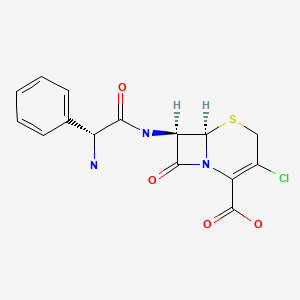Attribution Statement: LactMed is a registered trademark of the U.S. Department of Health and Human Services.
NCBI Bookshelf. A service of the National Library of Medicine, National Institutes of Health.
Drugs and Lactation Database (LactMed®) [Internet]. Bethesda (MD): National Institute of Child Health and Human Development; 2006-.
CASRN: 53994-73-3

Drug Levels and Effects
Summary of Use during Lactation
Cefaclor is no longer marketed in the United States. Limited information indicates that maternal cefaclor produces low levels in milk which are not expected to cause adverse effects in breastfed infants. Occasionally disruption of the infant's gastrointestinal flora, resulting in diarrhea or thrush have been reported with cephalosporins, but these effects have not been adequately evaluated. Cefaclor is acceptable in nursing mothers.
Drug Levels
Maternal Levels. A single dose of cefaclor 250 mg was given orally to 2 nursing mothers. In one mother it was undetectable in milk. In the other, levels of 0.15 to 0.19 mg/L occurred 2 to 4 hours after the dose; by 5 hours it was undetectable. In 5 mothers who received a single 500 mg oral dose, an average peak level of 0.21 mg/L occurred 4 hours after the dose. In individual patients, peak levels of 0.18 to 0.35 mg/L occurred 2 to 5 hours after the dose.[1]
Infant Levels. Relevant published information was not found as of the revision date.
Effects in Breastfed Infants
In a telephone follow-up study, 5 nursing mothers reported taking cefaclor (dosage unspecified). One mother reported diarrhea in her infant. No rashes or candidiasis were reported among the exposed infants.[2]
Effects on Lactation and Breastmilk
Relevant published information was not found as of the revision date.
References
- 1.
- Takase Z, Shirafuji H, Uchida M. Clinical and laboratory studies of cefaclor in the field of obstetrics and gynecology. Chemotherapy (Tokyo) 1979;27 (Suppl 7):666-72.
- 2.
- Ito S, Blajchman A, Stephenson M, et al. Prospective follow-up of adverse reactions in breast-fed infants exposed to maternal medication. Am J Obstet Gynecol 1993;168:1393-9. [PubMed: 8498418]
Substance Identification
Substance Name
Cefaclor
CAS Registry Number
53994-73-3
Disclaimer: Information presented in this database is not meant as a substitute for professional judgment. You should consult your healthcare provider for breastfeeding advice related to your particular situation. The U.S. government does not warrant or assume any liability or responsibility for the accuracy or completeness of the information on this Site.
- User and Medical Advice Disclaimer
- Drugs and Lactation Database (LactMed) - Record Format
- LactMed - Database Creation and Peer Review Process
- Fact Sheet. Drugs and Lactation Database (LactMed)
- Drugs and Lactation Database (LactMed) - Glossary
- LactMed Selected References
- Drugs and Lactation Database (LactMed) - About Dietary Supplements
- Breastfeeding Links
- PubChem SubstanceRelated PubChem Substances
- PubMedLinks to PubMed
- Review Cephalexin.[Drugs and Lactation Database (...]Review Cephalexin.. Drugs and Lactation Database (LactMed®). 2006
- Review Cefadroxil.[Drugs and Lactation Database (...]Review Cefadroxil.. Drugs and Lactation Database (LactMed®). 2006
- Review Ceftizoxime.[Drugs and Lactation Database (...]Review Ceftizoxime.. Drugs and Lactation Database (LactMed®). 2006
- Review Cefotaxime.[Drugs and Lactation Database (...]Review Cefotaxime.. Drugs and Lactation Database (LactMed®). 2006
- Review Cefazolin.[Drugs and Lactation Database (...]Review Cefazolin.. Drugs and Lactation Database (LactMed®). 2006
- Cefaclor - Drugs and Lactation Database (LactMed®)Cefaclor - Drugs and Lactation Database (LactMed®)
Your browsing activity is empty.
Activity recording is turned off.
See more...
